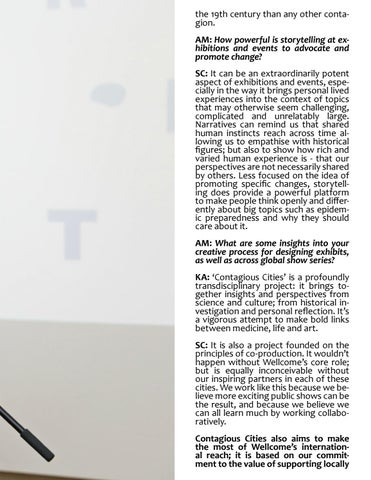the 19th century than any other contagion. AM: How powerful is storytelling at exhibitions and events to advocate and promote change? SC: It can be an extraordinarily potent aspect of exhibitions and events, especially in the way it brings personal lived experiences into the context of topics that may otherwise seem challenging, complicated and unrelatably large. Narratives can remind us that shared human instincts reach across time allowing us to empathise with historical figures; but also to show how rich and varied human experience is - that our perspectives are not necessarily shared by others. Less focused on the idea of promoting specific changes, storytelling does provide a powerful platform to make people think openly and differently about big topics such as epidemic preparedness and why they should care about it. AM: What are some insights into your creative process for designing exhibits, as well as across global show series? KA: ‘Contagious Cities’ is a profoundly transdisciplinary project: it brings together insights and perspectives from science and culture; from historical investigation and personal reflection. It’s a vigorous attempt to make bold links between medicine, life and art. SC: It is also a project founded on the principles of co-production. It wouldn’t happen without Wellcome’s core role; but is equally inconceivable without our inspiring partners in each of these cities. We work like this because we believe more exciting public shows can be the result, and because we believe we can all learn much by working collaboratively. Contagious Cities also aims to make the most of Wellcome’s international reach; it is based on our commitment to the value of supporting locally
Issuu converts static files into: digital portfolios, online yearbooks, online catalogs, digital photo albums and more. Sign up and create your flipbook.

